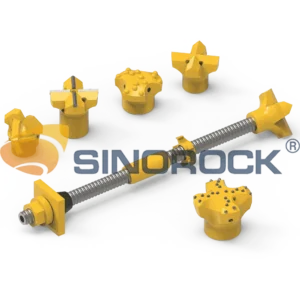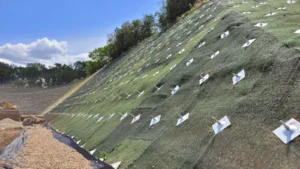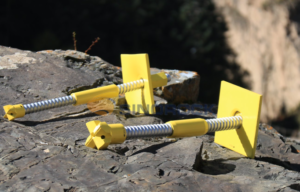1. Introduction
When it comes to geotechnical support in tunneling, mining, and construction projects, the question often arises: Can self-drilling hollow anchors achieve the ideal supporting effect? This question is crucial because a proper support system can make the difference between project success and failure, particularly in challenging ground conditions.
Self-drilling hollow anchor bars have emerged as a popular solution for underground support systems, but there is still some uncertainty surrounding their true capabilities. This article seeks to clarify whether these anchors can meet the rigorous standards required for stability and safety in a variety of applications.
2. Understanding Self-Drilling Hollow Anchors
Self-drilling hollow anchors are advanced ground stabilization systems designed to combine drilling, grouting, and anchoring into a single streamlined process. Unlike traditional anchors, their hollow-bar design allows simultaneous drilling and grout injection, significantly reducing installation time and improving load-bearing capacity. These anchors have become indispensable in modern construction, mining, and civil engineering due to their adaptability in unstable soils and high-stress environments.

Structure and Function:
A self-drilling hollow anchor consists of a hollow steel rod with a drill bit attached at one end. The anchor is drilled into the ground, and the hollow shaft allows for grout injection into the hole, securing the anchor in place. Once installed, the grout solidifies and bonds the anchor to the surrounding material, ensuring a stable support system.
Differences from Traditional Anchors:
Traditional anchor systems typically involve drilling, cleaning, and installing a separate bolt, followed by grouting. This multi-step process can lead to longer installation times, greater risk of misalignment, and potential gaps in the support structure. In contrast, self-drilling hollow anchors reduce the number of steps involved, leading to faster and more precise installations.
Materials and Design Considerations:
The materials used for self-drilling hollow anchors typically include high-strength steel or stainless steel, chosen for their durability and resistance to corrosion. The design of the anchors, including the size of the hollow shaft and the type of drill bit used, depends on the specific geotechnical conditions of the site.
3. Key Factors in Achieving the Ideal Supporting Effect
Several factors contribute to the ideal supporting effect in a rock or soil support system. The performance of self-drilling hollow anchors largely depends on these factors.
Geotechnical Conditions:
The type of rock or soil surrounding the anchor significantly affects its performance. In hard rock conditions, the anchor will need to withstand higher forces, while in softer soils, the anchor’s ability to spread load and prevent ground deformation is paramount. Groundwater, fault zones, and other geological features can also influence the behavior of self-drilling hollow anchors.
Load Transfer Mechanisms:
A key aspect of the supporting effect is the load transfer between the anchor and the surrounding material. Self-drilling hollow anchors distribute loads more efficiently due to their ability to inject grout, creating a stronger bond with the ground. This increases their capacity to bear the applied loads over time.
Installation Techniques:
The installation process itself can affect the anchor’s performance. Accurate drilling, correct grout placement, and proper alignment are essential to achieving the desired support. Misalignment or poor grout quality can result in suboptimal anchor performance, reducing its load-bearing capacity.
Engineering and Design:
The success of self-drilling hollow anchors in achieving the ideal supporting effect depends on detailed engineering. Factors like anchor length, diameter, grout material, and placement are critical to ensuring that the system performs as required under varying load conditions.
4. Applications in Tunneling and Mining
Self-drilling hollow anchors have proven their effectiveness in a wide range of applications, particularly in tunneling and mining projects.
Tunneling Projects:
In tunneling, self-drilling hollow anchors are commonly used to stabilize tunnel faces, prevent collapse, and reduce deformation. Their fast installation and ability to achieve deep anchorage make them ideal for high-pressure environments.
Mining and Construction:
Mining operations often require support systems capable of withstanding extreme conditions, including deep underground pressures and seismic activity. Self-drilling hollow anchors provide a reliable solution, offering both flexibility and strength.
Case Study: Sinorock’s Success in Challenging Conditions:
Sinorock has played a leading role in introducing advanced self-drilling hollow anchor technology. In the recent Tala Hydro Project, Sinorock’s hollow anchors were used to support tunnels in difficult geological conditions, demonstrating their effectiveness in providing long-term stability and minimizing ground deformation.
5. Challenges and Limitations
While self-drilling hollow anchors offer numerous benefits, there are also challenges to consider.
Corrosion and Wear:
Like all steel-based systems, self-drilling hollow anchors are susceptible to corrosion over time. To mitigate this, high-quality materials, such as stainless steel or corrosion-resistant coatings, are used in many applications.
Misalignment and Load Distribution:
If anchors are not installed correctly, misalignment can lead to uneven load distribution, reducing their effectiveness. Proper installation and quality control procedures are essential for ensuring anchors perform as designed.
Sinorock’s Role in Overcoming Challenges:
Sinorock’s continuous innovation in self-drilling hollow anchors has addressed many of these issues. With enhanced corrosion-resistant materials and precise engineering solutions, Sinorock products are designed to deliver optimal performance even in the most challenging environments.
6. Advantages of Self-Drilling Hollow Anchors
Self-drilling hollow anchors offer numerous advantages that make them an ideal choice for many geotechnical applications.
Faster Installation:
Since the drilling and grouting processes are combined, installation times are significantly reduced compared to traditional methods. This allows for quicker project turnaround and reduced labor costs.
Reduced Ground Deformation:
The self-drilling process minimizes ground disturbance, which reduces the risk of deformation during installation. This is particularly important in sensitive or unstable ground conditions.
Increased Load-Bearing Capacity:
Self-drilling hollow anchors are designed to handle high loads over extended periods. Their ability to distribute forces effectively results in increased stability for underground structures.
Flexibility Across Conditions:
Whether in hard rock or soft soil, self-drilling hollow anchors can be adapted to different ground conditions, making them versatile for a variety of applications.
7. Achieving the Ideal Supporting Effect: Is It Possible?
The “ideal” supporting effect refers to a system that provides maximum stability while minimizing ground deformation and project costs. While no support system is best perfect, self-drilling hollow anchors come very close to achieving this ideal in many applications.
By optimizing anchor design, installation techniques, and grout quality, the ideal supporting effect can be reached in a wide range of conditions. The key lies in engineering precision and the use of high-quality materials.
Sinorock’s advanced self-drilling hollow anchors are engineered to meet these demands, providing superior performance in various geotechnical projects.
8. Conclusion
Self-drilling hollow anchors are an effective solution for achieving the ideal supporting effect in geotechnical applications, especially in tunneling, mining, and construction. With their fast installation, high load-bearing capacity, and ability to adapt to various ground conditions, they offer significant advantages over traditional anchor systems.
While challenges like ground conditions and corrosion exist, advancements in material science and engineering solutions, such as those provided by Sinorock, continue to improve anchor performance and longevity. As the industry evolves, self-drilling hollow anchors will undoubtedly play a pivotal role in ensuring the stability and safety of underground structures for years to come.





